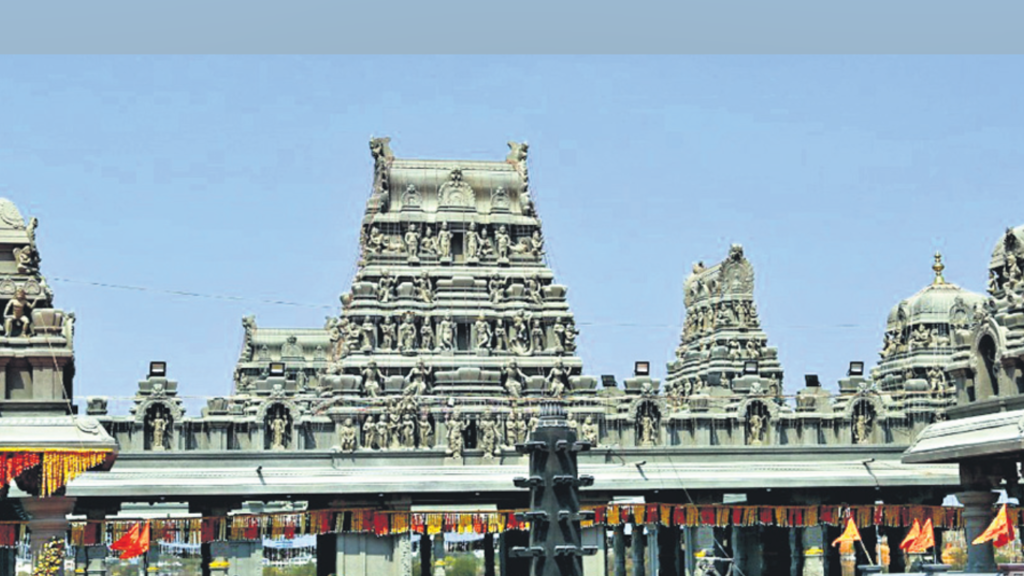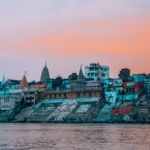Nestled atop Manepally Hills in Bhuvanagiri, Telangana, the Swarnagiri Sri Venkateswara Swamy Temple is a stunning new pilgrimage site, just 47.3 km from Hyderabad. Dedicated to Lord Venkateswara, this temple, built by the Manepally family and opened in March 2024, blends Dravidian architecture with spiritual charm. Its 12-foot-tall deity statue and serene hilltop setting draw thousands seeking blessings. Knowing the temple’s timings is key to planning a peaceful visit. Open daily from 5:00 AM to 9:00 PM, with a break from 1:30 PM to 2:30 PM on weekdays, it offers various darshan and sevas like Suprabhatam and Archana. This article details Swarnagiri temple timings, rituals, travel tips, and nearby attractions.
Temple Timings and Daily Schedule
The Swarnagiri Temple welcomes devotees daily from 5:00 AM to 9:00 PM, with a weekday break from 1:30 PM to 2:30 PM for rituals. The day starts with Suprabhatam Seva at 5:00 AM, a morning prayer to awaken Lord Venkateswara. Key darshan times include 8:00 AM–12:00 PM and 2:30 PM–6:00 PM for Sarva Darshanam (free entry) and special sevas like Archana. The temple closes after Ekantha Seva at 8:30 PM, a private ritual. Festival days, like Vaikuntha Ekadashi, may extend hours until midnight. Visitors should arrive 15 minutes early for booked sevas, as per the temple’s website. Checking the official schedule online ensures you catch your preferred darshan or pooja, making your visit smooth and spiritually fulfilling.
Morning Rituals
The temple opens at 5:00 AM with Suprabhatam Seva, a 30-minute ritual of Vedic hymns to honor Lord Venkateswara. By 7:00 AM, Sahasranama Archana chants the Lord’s thousand names, lasting 20 minutes. These early sevas are perfect for devotees seeking a calm start. Sarva Darshanam begins at 8:00 AM, allowing free entry to see the deity. Booking morning sevas like Archana (Rs. 119) via swarnagiritemple.com ensures a spot. Arrive early to avoid crowds, especially on weekends, and soak in the serene hilltop atmosphere.
Evening Rituals
Evening rituals start after the 2:30 PM reopening with Archana and Veda Ashirvachanam sevas. Suvarna Pushpa Archana, a special flower offering, happens around 6:00 PM, costing Rs. 119. The day ends with Ekantha Seva at 8:30 PM, a quiet ritual for the deity’s rest. Aarti fills the temple with devotion in the evening, creating a magical vibe. Festival evenings, like Brahmotsavam, feature processions, extending hours. Book sevas early and dress modestly to join these sacred moments under the temple’s glowing lights.
Types of Darshan and Sevas
Swarnagiri offers various darshan and seva options to suit devotees’ needs. Sarva Darshanam is free, available during morning and afternoon slots, ideal for general visitors. Paid options include Dakshina Queue (Rs. 50), Seegra Darshanam (faster entry), and Donor Darshanam (Rs. 1,000 for four people) with Veda Ashirvachanam. Sevas like Archana (15 minutes, Rs. 119), Abhishekam (20–30 minutes, Rs. 172), and Sindhura Archan (30 minutes, Rs. 119) allow closer connection with the deity. Special rituals, like Suvarna Pushpa Archana, add spiritual depth. Book via swarnagiritemple.com to secure your slot, as spots fill fast during festivals like Navratri, ensuring a hassle-free experience.
Free vs. Paid Darshan
Sarva Darshanam, free for all, runs from 8:00 AM–12:00 PM and 2:30 PM–6:00 PM, but expect longer waits on weekends. Paid options like Dakshina Queue (Rs. 50) and Seegra Darshanam offer quicker access, saving time for busy visitors. Donor Darshanam (Rs. 1,000) includes perks like Veda Ashirvachanam for four people, ideal for families. Free darshan suits budget travelers, while paid options ensure faster entry and a more personal experience. Choose based on your schedule and budget, checking availability online.
Booking Sevas Online
Booking sevas is easy through swarnagiritemple.com. Select from Archana, Abhishekam, or Sindhura Archan, with prices starting at Rs. 119. Register with your details, choose a time slot, and pay online. Arrive 15 minutes early with your booking confirmation. Special sevas, like Suvarna Pushpa Archana, require advance booking, especially during festivals like Brahmotsavam. The website lists costs and durations (15–30 minutes), helping you plan. Online booking saves time and guarantees your spot, letting you focus on the spiritual experience without last-minute stress.
Best Times to Visit
The temple is open year-round, but timing your visit enhances the experience. Early mornings (5:00 AM–8:00 AM) offer a peaceful darshan with fewer crowds, perfect for quiet prayer. Late afternoons (4:00 PM–6:00 PM) are ideal for enjoying the hilltop’s scenic views and cooler weather. Festivals like Vaikuntha Ekadashi or Brahmotsavam (March–April) bring vibrant celebrations but heavy crowds, with extended hours until midnight. Monsoon (July–September) adds lush greenery, though the 600-step climb can be slippery. Winters (October–February) are comfortable for trekking. Avoid peak festival days if you prefer a calm visit, and check swarnagiritemple.com for event schedules to plan around special sevas or processions.
Festival Days
Festivals like Brahmotsavam, Vaikuntha Ekadashi, and Navratri transform Swarnagiri into a lively hub. Brahmotsavam (March–April) features 10 days of processions and sevas, drawing thousands. Vaikuntha Ekadashi includes special prayers, with darshan until midnight. Navratri offers extra pujas and cultural events, enriching the spiritual vibe. These days are packed, so book sevas early via swarnagiritemple.com. Arrive by 5:00 AM to beat the rush and enjoy the festive energy, including Thiruveedhi Utsavam processions and illuminated gopurams, making your visit unforgettable.
Off-Peak Seasons
For a quieter visit, choose non-festival days, especially weekdays in monsoon or winter. July–September brings greenery, ideal for the 600-step trek, though carry rain gear. October–February offers pleasant weather, making the climb comfortable. Mornings around 6:00 AM or afternoons after 4:00 PM see fewer visitors, ensuring a serene darshan. Off-peak visits allow more time to explore the temple’s Dravidian architecture, like the 108-foot Rajagopuram, and nearby sites like Bhongir Fort, enhancing your spiritual and sightseeing experience without the festival crowds.
How to Reach Swarnagiri Temple
Located on Manepally Hills, Bhuvanagiri, the temple is 47.3 km from Hyderabad, a 1.5-hour drive via NH163. From Hyderabad, take the highway from Uppal, following signs to Anantharam Rural. Local buses from MGBS or Secunderabad to Bhuvanagiri cost Rs. 50–100. Bhongir Railway Station, 2 km away, connects to Hyderabad and Warangal, with taxis available (Rs. 100–200). The nearest airport, Rajiv Gandhi International (76 km), offers cabs for Rs. 1,500–2,000. The temple has ample parking (Rs. 50 for cars), but the approach road is partly under construction, so check routes. Climb 600 steps or use limited shuttle services for accessibility, ensuring a smooth journey to this sacred site.
By Road and Bus
Driving from Hyderabad via NH163 takes 1.5 hours, covering 47.3 km. Start from Uppal, take a U-turn at the highway, and follow two entry roads to Manepally Hills. Buses from MGBS or Jubilee Bus Station to Bhuvanagiri run every 30 minutes, costing Rs. 50–100. Auto-rickshaws from Bhuvanagiri town to the temple charge Rs. 50–80. The ongoing road construction may cause minor delays, so use GPS for updates. Ample parking (Rs. 50) is available, making road travel convenient for families and groups visiting for darshan or sevas.
By Train and Air
Bhongir Railway Station, 2 km from the temple, connects to Hyderabad (44 km) and Warangal. Trains like the Hyderabad-Warangal Express take 1 hour from Secunderabad. Taxis or autos from the station cost Rs. 100–200. For air travelers, Rajiv Gandhi International Airport (76 km) is the closest, with cabs or rentals available for Rs. 1,500–2,000. The drive takes 2 hours via the Outer Ring Road. Book transport in advance, especially during festivals, to ensure a smooth trip to Swarnagiri’s hilltop, where you can ascend 600 steps for darshan.
Temple History and Significance
Built by the Manepally family, Swarnagiri Temple was consecrated on March 7, 2024, after a miracle in 2016 when holy water from Tirupati revived Srimati Vijaya Lakshmi from a coma. Costing Rs. 500 crores, the 22-acre complex features a 12-foot Lord Venkateswara statue, the largest in Telangana, crafted in Dravidian style with Pallava and Chola influences. The temple, inspired by Tirumala, follows Sri Pancharatra Agama rituals. Its four Rajagopurams, Jala Narayana Swami Sannidhi, and 40-foot Hanuman statue draw devotees. Managed by the Srivari Seva Trust, it promotes charity and culture, making it a spiritual and architectural gem in South India.
Miracle Behind Construction
In 2016, Srimati Vijaya Lakshmi, wife of businessman Sriman Manepalli Rama Rao, survived a coma after a severe accident, thanks to Tirupati’s holy water. This miracle inspired the family to build Swarnagiri Temple, starting in 2018. Led by their sons, Muralikrishna and Gopikrishna, the project took seven years, costing Rs. 500 crores. The temple, opened in 2024, stands as a tribute to Lord Venkateswara’s grace, attracting devotees seeking similar blessings and reinforcing its spiritual significance as a place of faith and miracles.
Architectural Marvel
Swarnagiri’s Dravidian architecture blends Pallava, Vijayanagara, and Chola styles. Its 108-foot main Rajagopuram and four gateway towers awe visitors. The 12-foot Lord Venkateswara statue, carved from black granite, shines with gold and silver. A five-story Vimana Gopuram crowns the sanctum, while intricate carvings depict Hindu epics. Features like the Jala Narayana Swami Sannidhi, illuminated at night, and a 40-foot Hanuman statue add grandeur. Built without cement using stone interlocking, the temple ensures longevity, making it a cultural and spiritual landmark.
Visitor Tips and Guidelines
Plan your visit to Swarnagiri with these tips: Arrive early (5:00 AM–6:00 AM) for a calm darshan. Wear modest clothing—women should cover heads, men wear dhotis or trousers. Remove shoes and deposit mobiles (Rs. 5) outside, as they’re banned inside. Climb 600 steps, so wear comfy shoes and carry water; the trek is slippery in rains. Book sevas on swarnagiritemple.com to avoid queues. No entry fee for general darshan, but respect rituals and stay quiet. Check weather, as monsoon steps are tricky. Parking costs Rs. 50, and limited wheelchair access is available—call ahead for assistance.
Dress Code and Etiquette
Dress modestly: women wear sarees or salwar suits with headscarves; men choose dhotis or formal pants. Remove footwear before entering and deposit phones at the counter (Rs. 5). Maintain silence during sevas and avoid touching idols. Offer prasadam only at designated counters. Respect priests and fellow devotees, especially during crowded festivals. Follow signs for queues and rituals to ensure a smooth visit. These rules honor the temple’s sanctity, letting everyone enjoy the spiritual experience without disruptions.
Accessibility and Facilities
The temple requires climbing 600 steps, which may challenge elderly or disabled visitors. Limited shuttle services and wheelchair access are available—contact swarnagiritemple.com in advance. Ample parking (Rs. 50) and restrooms are provided. Food stalls offer prasadam, but carry snacks for the trek. Budget lodges in Bhuvanagiri or hotels in Hyderabad (47 km away) suit overnight stays. Drinking water is available, but bring a bottle for the climb. Ongoing construction may limit some areas, so check updates before visiting for a comfortable trip.
Nearby Attractions
Swarnagiri’s location offers nearby gems for visitors. Bhongir Fort, a 10th-century hill fort 2 km away, boasts stunning views and historical ruins, perfect for a 1-hour hike. Yadagirigutta Temple, 19.7 km away, dedicated to Lord Narasimha, offers spiritual serenity amid greenery. Surendrapuri, a 20-minute drive, features mythological idols for a 2–3-hour tour. Laknavaram Lake, 20 km away, is ideal for boating and picnics. These spots complement your temple visit, blending history, culture, and nature for a fulfilling day trip from Hyderabad.
Bhongir Fort
Just 2 km from Swarnagiri, Bhongir Fort is a 10th-century hilltop marvel built by the Chalukyas. Climb its rocky path for panoramic views of Bhuvanagiri, taking about 1 hour. The fort’s ruins, including old walls and gateways, whisper tales of ancient rulers. Entry is Rs. 20, and mornings are best to avoid heat. Combine it with your temple visit for a mix of spirituality and history, easily accessible by auto-rickshaw (Rs. 50) from the temple’s base, making it a must-see.
Yadagirigutta Temple
Located 19.7 km away, Yadagirigutta Temple honors Lord Narasimha. Set on a hill with lush greenery, it’s a 30-minute drive from Swarnagiri. Open from 4:00 AM to 9:30 PM, it offers free darshan and sevas like Kalyanotsavam. The temple’s cave-like sanctum and serene vibe draw devotees. Visit after Swarnagiri’s morning darshan to maximize your day. Autos or cabs (Rs. 300–500) connect the sites, letting you explore Telangana’s spiritual heritage in one trip.



